Taxation Law
VerifiedAdded on 2023/04/21
|12
|2764
|378
AI Summary
This document provides an in-depth analysis of taxation law, including the concept of ordinary income, deductions, fringe benefits, and more. It also discusses relevant case laws and their implications. Suitable for students studying taxation law.
Contribute Materials
Your contribution can guide someone’s learning journey. Share your
documents today.

Running head: TAXATION LAW
Taxation Law
Name of the Student
Name of the University
Authors Note
Course ID
Taxation Law
Name of the Student
Name of the University
Authors Note
Course ID
Secure Best Marks with AI Grader
Need help grading? Try our AI Grader for instant feedback on your assignments.
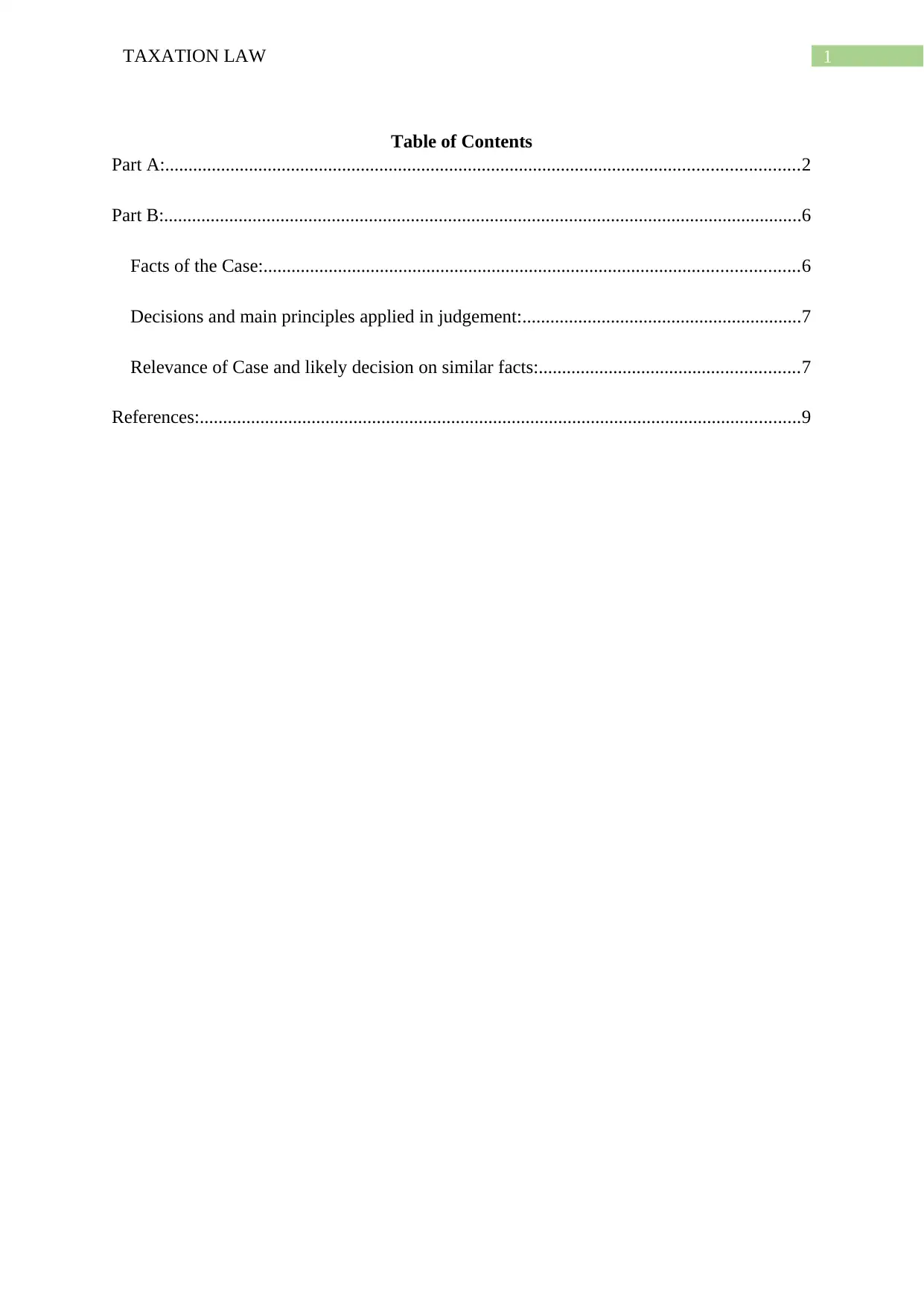
1TAXATION LAW
Table of Contents
Part A:........................................................................................................................................2
Part B:.........................................................................................................................................6
Facts of the Case:...................................................................................................................6
Decisions and main principles applied in judgement:............................................................7
Relevance of Case and likely decision on similar facts:........................................................7
References:.................................................................................................................................9
Table of Contents
Part A:........................................................................................................................................2
Part B:.........................................................................................................................................6
Facts of the Case:...................................................................................................................6
Decisions and main principles applied in judgement:............................................................7
Relevance of Case and likely decision on similar facts:........................................................7
References:.................................................................................................................................9
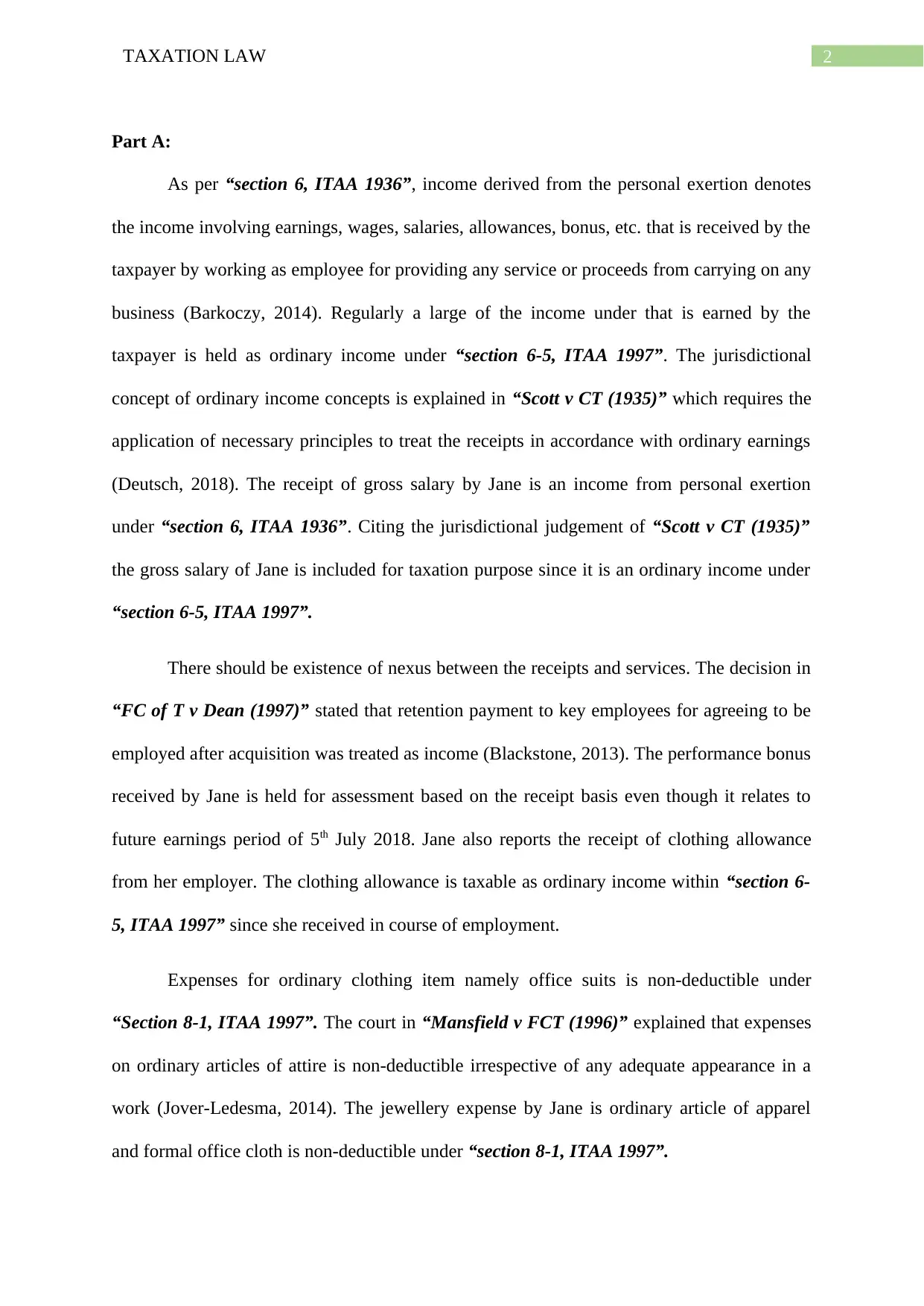
2TAXATION LAW
Part A:
As per “section 6, ITAA 1936”, income derived from the personal exertion denotes
the income involving earnings, wages, salaries, allowances, bonus, etc. that is received by the
taxpayer by working as employee for providing any service or proceeds from carrying on any
business (Barkoczy, 2014). Regularly a large of the income under that is earned by the
taxpayer is held as ordinary income under “section 6-5, ITAA 1997”. The jurisdictional
concept of ordinary income concepts is explained in “Scott v CT (1935)” which requires the
application of necessary principles to treat the receipts in accordance with ordinary earnings
(Deutsch, 2018). The receipt of gross salary by Jane is an income from personal exertion
under “section 6, ITAA 1936”. Citing the jurisdictional judgement of “Scott v CT (1935)”
the gross salary of Jane is included for taxation purpose since it is an ordinary income under
“section 6-5, ITAA 1997”.
There should be existence of nexus between the receipts and services. The decision in
“FC of T v Dean (1997)” stated that retention payment to key employees for agreeing to be
employed after acquisition was treated as income (Blackstone, 2013). The performance bonus
received by Jane is held for assessment based on the receipt basis even though it relates to
future earnings period of 5th July 2018. Jane also reports the receipt of clothing allowance
from her employer. The clothing allowance is taxable as ordinary income within “section 6-
5, ITAA 1997” since she received in course of employment.
Expenses for ordinary clothing item namely office suits is non-deductible under
“Section 8-1, ITAA 1997”. The court in “Mansfield v FCT (1996)” explained that expenses
on ordinary articles of attire is non-deductible irrespective of any adequate appearance in a
work (Jover-Ledesma, 2014). The jewellery expense by Jane is ordinary article of apparel
and formal office cloth is non-deductible under “section 8-1, ITAA 1997”.
Part A:
As per “section 6, ITAA 1936”, income derived from the personal exertion denotes
the income involving earnings, wages, salaries, allowances, bonus, etc. that is received by the
taxpayer by working as employee for providing any service or proceeds from carrying on any
business (Barkoczy, 2014). Regularly a large of the income under that is earned by the
taxpayer is held as ordinary income under “section 6-5, ITAA 1997”. The jurisdictional
concept of ordinary income concepts is explained in “Scott v CT (1935)” which requires the
application of necessary principles to treat the receipts in accordance with ordinary earnings
(Deutsch, 2018). The receipt of gross salary by Jane is an income from personal exertion
under “section 6, ITAA 1936”. Citing the jurisdictional judgement of “Scott v CT (1935)”
the gross salary of Jane is included for taxation purpose since it is an ordinary income under
“section 6-5, ITAA 1997”.
There should be existence of nexus between the receipts and services. The decision in
“FC of T v Dean (1997)” stated that retention payment to key employees for agreeing to be
employed after acquisition was treated as income (Blackstone, 2013). The performance bonus
received by Jane is held for assessment based on the receipt basis even though it relates to
future earnings period of 5th July 2018. Jane also reports the receipt of clothing allowance
from her employer. The clothing allowance is taxable as ordinary income within “section 6-
5, ITAA 1997” since she received in course of employment.
Expenses for ordinary clothing item namely office suits is non-deductible under
“Section 8-1, ITAA 1997”. The court in “Mansfield v FCT (1996)” explained that expenses
on ordinary articles of attire is non-deductible irrespective of any adequate appearance in a
work (Jover-Ledesma, 2014). The jewellery expense by Jane is ordinary article of apparel
and formal office cloth is non-deductible under “section 8-1, ITAA 1997”.

3TAXATION LAW
Simple winning of prize is not an income but it may be an income if there is enough
relation with taxpayer income producing activity. In “FC of T v Kelly (1985)” the
professional footballer received an award for being the best player. The award constituted
taxable income because it was related to work and employment and was associated to use of
skills (McCouat, 2018). The award to Jane by ICA ANZ for being the best accountant is a
taxable income because it was related to work and was linked to use of Jane accounting
knowledge. While the computer received in award valued $2,550. Referring to “Cooke and
Sherden v FCT (1980)” gains that cannot be converted to income is treated as ordinary
income. The computer that is received by Jane is a taxable gain that can be converted to cash
and it is included for taxable purpose within the meaning of ordinary concept of income
under “section 6-5, ITAA 1997”.
Where an employer provides any kind of fringe benefit to an employee the benefit
will be treated as the non-taxable income for the employee under “section 23L of the ITAA
1936”. The employer however will be liable for fringe benefit tax on the value of the fringe
benefit (Kenny et al., 2018). The membership fees paid by the employer in respect of Jane
will be non-taxable for Jane under “section 23L, ITAA 1997” while her employer Milton
Hotels Ltd will be liable for FBT relating to value of benefit provided.
As per the ATO, the taxpayers are permitted to obtain an allowable income tax
deduction for expenses incurred in attending conferences, seminars or work related
educational workshop. Nevertheless, the personal portion of the expenses should be excluded
incurred during trip as they are non-deductible (Sadiq et al., 2014). Jane here will be allowed
to claim deduction for the registration fees, air tickets for her part and accommodation
expenses. She will be denied deduction for her husband air tickets and expenses occurred in
visiting historical place in Australia. These expenses are private in nature and not work
related.
Simple winning of prize is not an income but it may be an income if there is enough
relation with taxpayer income producing activity. In “FC of T v Kelly (1985)” the
professional footballer received an award for being the best player. The award constituted
taxable income because it was related to work and employment and was associated to use of
skills (McCouat, 2018). The award to Jane by ICA ANZ for being the best accountant is a
taxable income because it was related to work and was linked to use of Jane accounting
knowledge. While the computer received in award valued $2,550. Referring to “Cooke and
Sherden v FCT (1980)” gains that cannot be converted to income is treated as ordinary
income. The computer that is received by Jane is a taxable gain that can be converted to cash
and it is included for taxable purpose within the meaning of ordinary concept of income
under “section 6-5, ITAA 1997”.
Where an employer provides any kind of fringe benefit to an employee the benefit
will be treated as the non-taxable income for the employee under “section 23L of the ITAA
1936”. The employer however will be liable for fringe benefit tax on the value of the fringe
benefit (Kenny et al., 2018). The membership fees paid by the employer in respect of Jane
will be non-taxable for Jane under “section 23L, ITAA 1997” while her employer Milton
Hotels Ltd will be liable for FBT relating to value of benefit provided.
As per the ATO, the taxpayers are permitted to obtain an allowable income tax
deduction for expenses incurred in attending conferences, seminars or work related
educational workshop. Nevertheless, the personal portion of the expenses should be excluded
incurred during trip as they are non-deductible (Sadiq et al., 2014). Jane here will be allowed
to claim deduction for the registration fees, air tickets for her part and accommodation
expenses. She will be denied deduction for her husband air tickets and expenses occurred in
visiting historical place in Australia. These expenses are private in nature and not work
related.
Secure Best Marks with AI Grader
Need help grading? Try our AI Grader for instant feedback on your assignments.
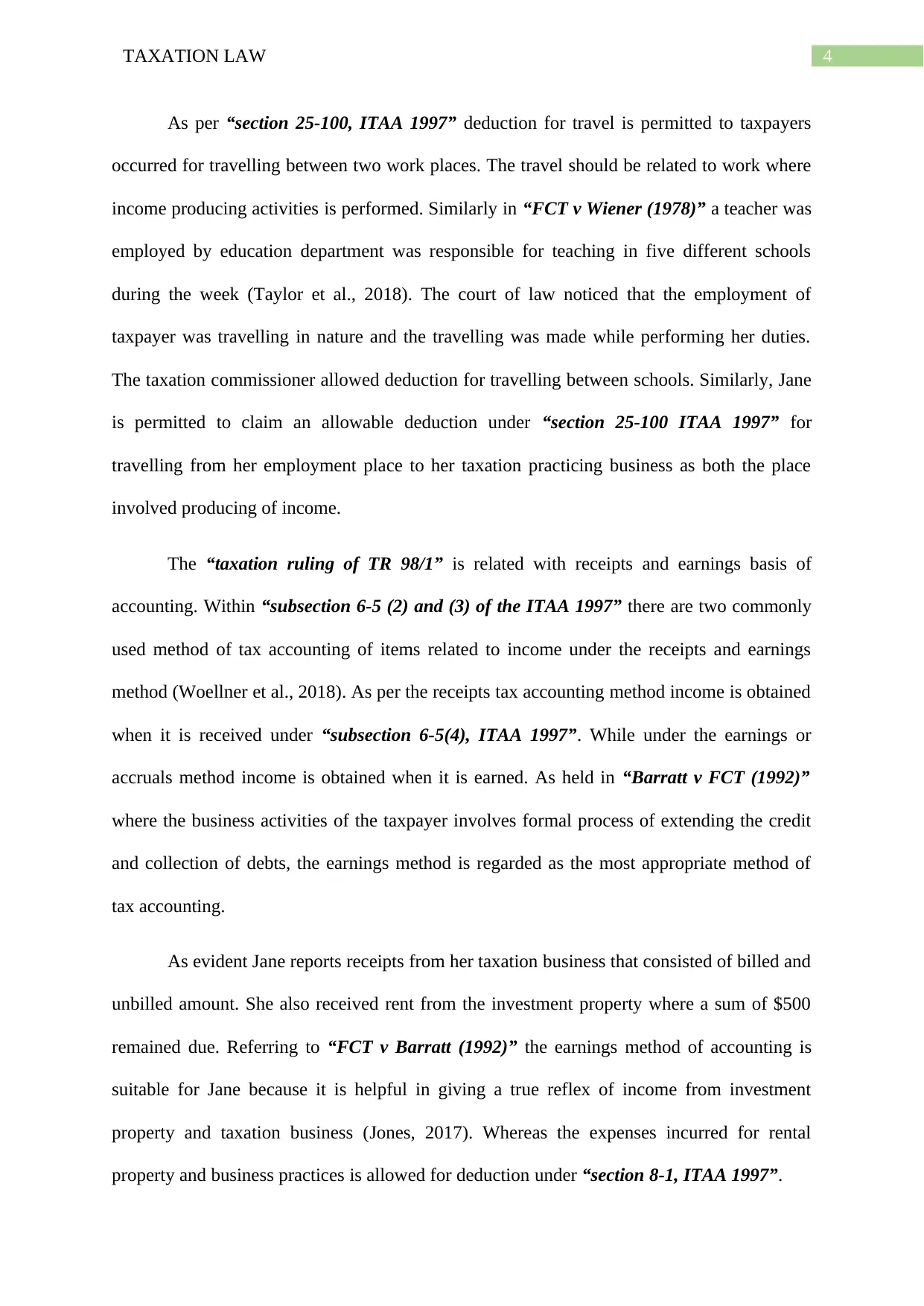
4TAXATION LAW
As per “section 25-100, ITAA 1997” deduction for travel is permitted to taxpayers
occurred for travelling between two work places. The travel should be related to work where
income producing activities is performed. Similarly in “FCT v Wiener (1978)” a teacher was
employed by education department was responsible for teaching in five different schools
during the week (Taylor et al., 2018). The court of law noticed that the employment of
taxpayer was travelling in nature and the travelling was made while performing her duties.
The taxation commissioner allowed deduction for travelling between schools. Similarly, Jane
is permitted to claim an allowable deduction under “section 25-100 ITAA 1997” for
travelling from her employment place to her taxation practicing business as both the place
involved producing of income.
The “taxation ruling of TR 98/1” is related with receipts and earnings basis of
accounting. Within “subsection 6-5 (2) and (3) of the ITAA 1997” there are two commonly
used method of tax accounting of items related to income under the receipts and earnings
method (Woellner et al., 2018). As per the receipts tax accounting method income is obtained
when it is received under “subsection 6-5(4), ITAA 1997”. While under the earnings or
accruals method income is obtained when it is earned. As held in “Barratt v FCT (1992)”
where the business activities of the taxpayer involves formal process of extending the credit
and collection of debts, the earnings method is regarded as the most appropriate method of
tax accounting.
As evident Jane reports receipts from her taxation business that consisted of billed and
unbilled amount. She also received rent from the investment property where a sum of $500
remained due. Referring to “FCT v Barratt (1992)” the earnings method of accounting is
suitable for Jane because it is helpful in giving a true reflex of income from investment
property and taxation business (Jones, 2017). Whereas the expenses incurred for rental
property and business practices is allowed for deduction under “section 8-1, ITAA 1997”.
As per “section 25-100, ITAA 1997” deduction for travel is permitted to taxpayers
occurred for travelling between two work places. The travel should be related to work where
income producing activities is performed. Similarly in “FCT v Wiener (1978)” a teacher was
employed by education department was responsible for teaching in five different schools
during the week (Taylor et al., 2018). The court of law noticed that the employment of
taxpayer was travelling in nature and the travelling was made while performing her duties.
The taxation commissioner allowed deduction for travelling between schools. Similarly, Jane
is permitted to claim an allowable deduction under “section 25-100 ITAA 1997” for
travelling from her employment place to her taxation practicing business as both the place
involved producing of income.
The “taxation ruling of TR 98/1” is related with receipts and earnings basis of
accounting. Within “subsection 6-5 (2) and (3) of the ITAA 1997” there are two commonly
used method of tax accounting of items related to income under the receipts and earnings
method (Woellner et al., 2018). As per the receipts tax accounting method income is obtained
when it is received under “subsection 6-5(4), ITAA 1997”. While under the earnings or
accruals method income is obtained when it is earned. As held in “Barratt v FCT (1992)”
where the business activities of the taxpayer involves formal process of extending the credit
and collection of debts, the earnings method is regarded as the most appropriate method of
tax accounting.
As evident Jane reports receipts from her taxation business that consisted of billed and
unbilled amount. She also received rent from the investment property where a sum of $500
remained due. Referring to “FCT v Barratt (1992)” the earnings method of accounting is
suitable for Jane because it is helpful in giving a true reflex of income from investment
property and taxation business (Jones, 2017). Whereas the expenses incurred for rental
property and business practices is allowed for deduction under “section 8-1, ITAA 1997”.
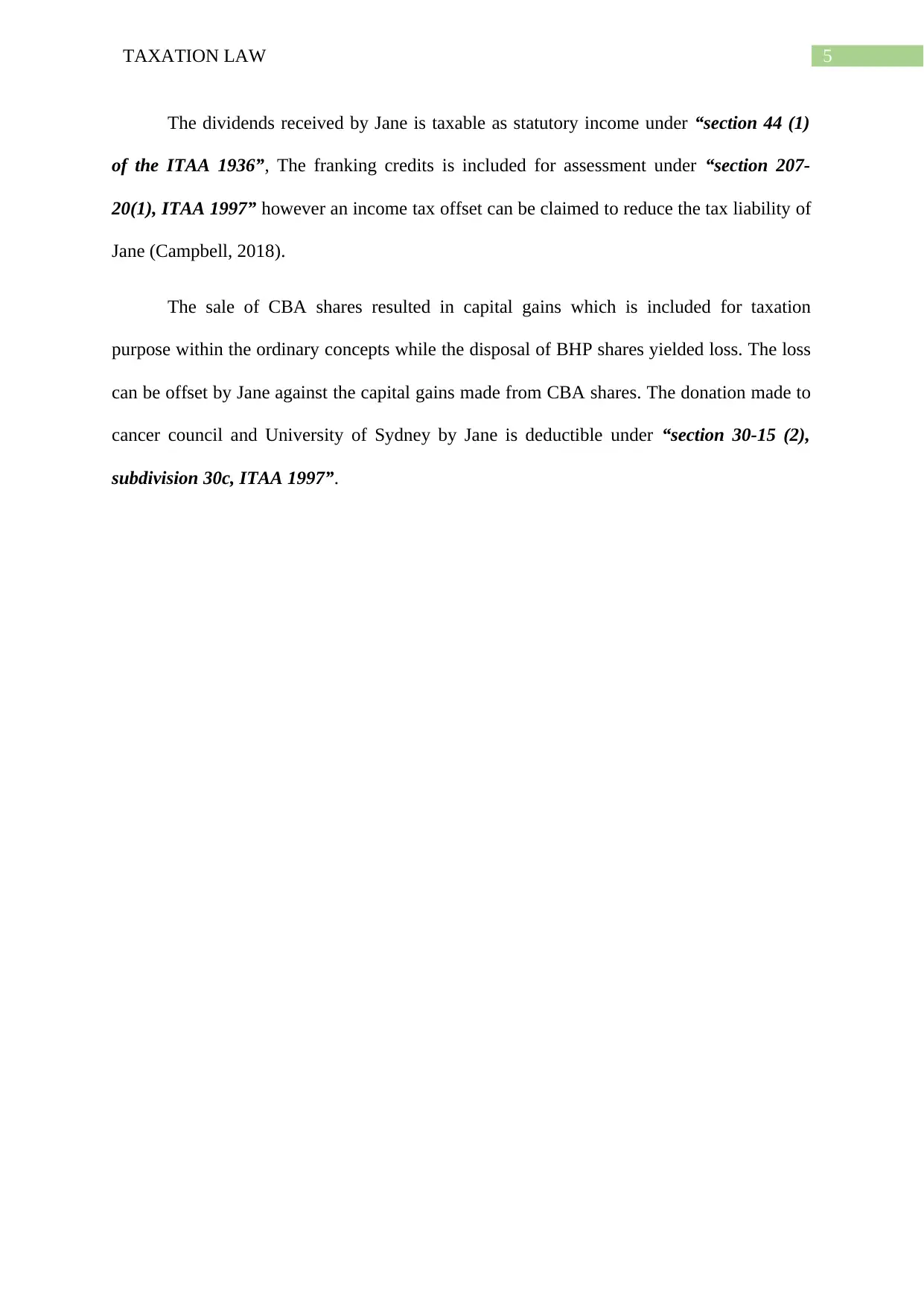
5TAXATION LAW
The dividends received by Jane is taxable as statutory income under “section 44 (1)
of the ITAA 1936”, The franking credits is included for assessment under “section 207-
20(1), ITAA 1997” however an income tax offset can be claimed to reduce the tax liability of
Jane (Campbell, 2018).
The sale of CBA shares resulted in capital gains which is included for taxation
purpose within the ordinary concepts while the disposal of BHP shares yielded loss. The loss
can be offset by Jane against the capital gains made from CBA shares. The donation made to
cancer council and University of Sydney by Jane is deductible under “section 30-15 (2),
subdivision 30c, ITAA 1997”.
The dividends received by Jane is taxable as statutory income under “section 44 (1)
of the ITAA 1936”, The franking credits is included for assessment under “section 207-
20(1), ITAA 1997” however an income tax offset can be claimed to reduce the tax liability of
Jane (Campbell, 2018).
The sale of CBA shares resulted in capital gains which is included for taxation
purpose within the ordinary concepts while the disposal of BHP shares yielded loss. The loss
can be offset by Jane against the capital gains made from CBA shares. The donation made to
cancer council and University of Sydney by Jane is deductible under “section 30-15 (2),
subdivision 30c, ITAA 1997”.

6TAXATION LAW
Particulars Amount ($) Amount ($)
Assesssable Income
Income from Taxation business
Receipts from service fees (Billed) 45000
Receipts from service fees (Un-Billed) 5000
Gross Salary 50000
Performance Bonus 25000
Receipt of Computer 2550
Clothing Allowance 4500
Receipts from Cash Award 5000
Receipts from rent 13000
Australian Sourced Dividend Income
Fully Franked dividend from CBA 7000
Franking Credits (7000 x 30 /70) 3000 10000
Franked Dividend BHP Shares
Fully Franked (Net) 3500
Gross up for franking credits (3500 x 50% x 30/70) 750 4250
Net Capital Gains/Loss
CBA Shares
Proceeds 60000
Cost Base 50000
Gross Capital gains 10000
50% CGT Discount 5000 5000
BHP Shares
Proceeds 10000
Cost Base 15000
Gross Capital loss -5000 -5000
Total Assessable Income 164300
Computation of Net Income
In the Books of Jane
For the Year Ended 30th June 2018
Particulars Amount ($) Amount ($)
Assesssable Income
Income from Taxation business
Receipts from service fees (Billed) 45000
Receipts from service fees (Un-Billed) 5000
Gross Salary 50000
Performance Bonus 25000
Receipt of Computer 2550
Clothing Allowance 4500
Receipts from Cash Award 5000
Receipts from rent 13000
Australian Sourced Dividend Income
Fully Franked dividend from CBA 7000
Franking Credits (7000 x 30 /70) 3000 10000
Franked Dividend BHP Shares
Fully Franked (Net) 3500
Gross up for franking credits (3500 x 50% x 30/70) 750 4250
Net Capital Gains/Loss
CBA Shares
Proceeds 60000
Cost Base 50000
Gross Capital gains 10000
50% CGT Discount 5000 5000
BHP Shares
Proceeds 10000
Cost Base 15000
Gross Capital loss -5000 -5000
Total Assessable Income 164300
Computation of Net Income
In the Books of Jane
For the Year Ended 30th June 2018
Paraphrase This Document
Need a fresh take? Get an instant paraphrase of this document with our AI Paraphraser
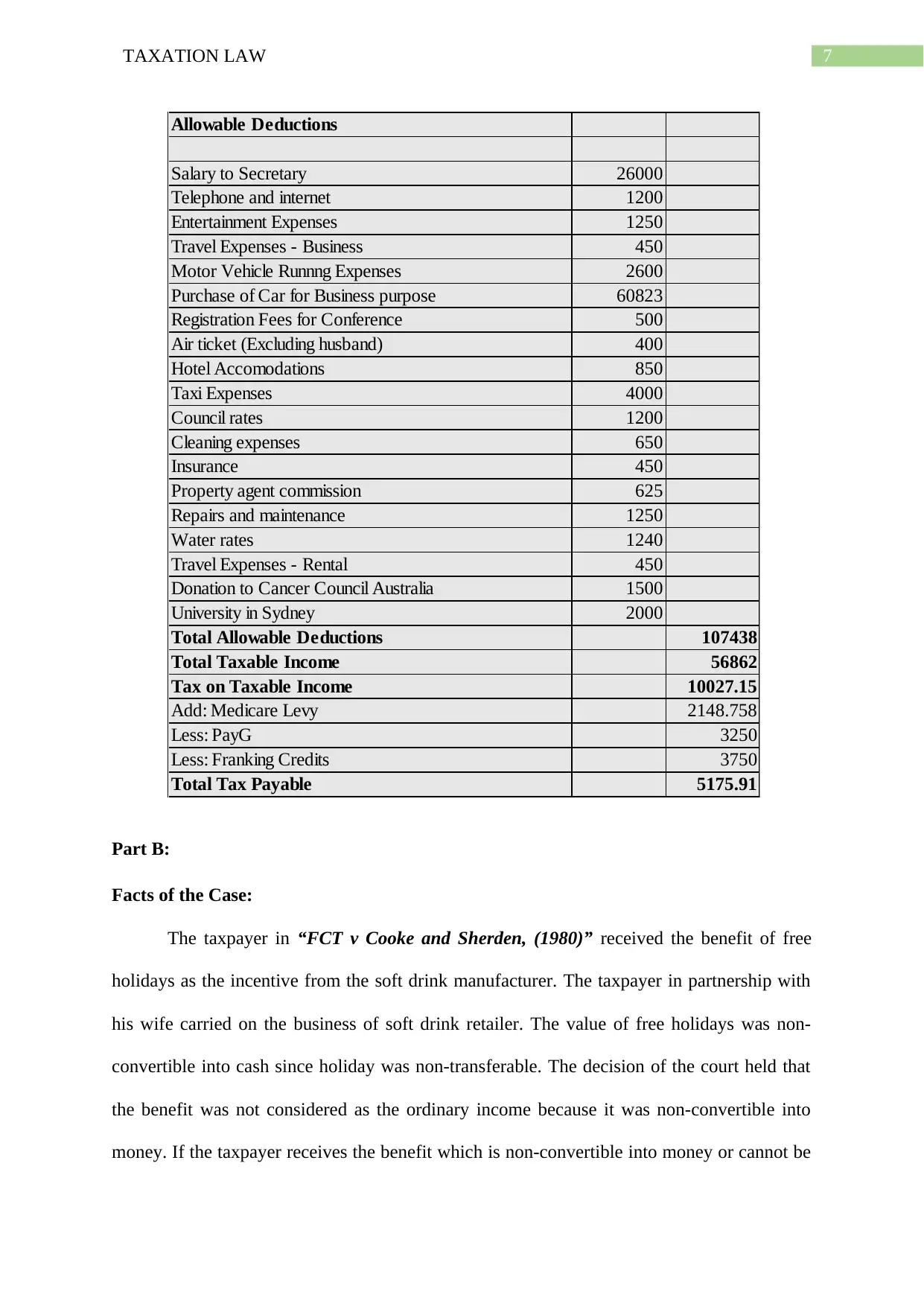
7TAXATION LAW
Allowable Deductions
Salary to Secretary 26000
Telephone and internet 1200
Entertainment Expenses 1250
Travel Expenses - Business 450
Motor Vehicle Runnng Expenses 2600
Purchase of Car for Business purpose 60823
Registration Fees for Conference 500
Air ticket (Excluding husband) 400
Hotel Accomodations 850
Taxi Expenses 4000
Council rates 1200
Cleaning expenses 650
Insurance 450
Property agent commission 625
Repairs and maintenance 1250
Water rates 1240
Travel Expenses - Rental 450
Donation to Cancer Council Australia 1500
University in Sydney 2000
Total Allowable Deductions 107438
Total Taxable Income 56862
Tax on Taxable Income 10027.15
Add: Medicare Levy 2148.758
Less: PayG 3250
Less: Franking Credits 3750
Total Tax Payable 5175.91
Part B:
Facts of the Case:
The taxpayer in “FCT v Cooke and Sherden, (1980)” received the benefit of free
holidays as the incentive from the soft drink manufacturer. The taxpayer in partnership with
his wife carried on the business of soft drink retailer. The value of free holidays was non-
convertible into cash since holiday was non-transferable. The decision of the court held that
the benefit was not considered as the ordinary income because it was non-convertible into
money. If the taxpayer receives the benefit which is non-convertible into money or cannot be
Allowable Deductions
Salary to Secretary 26000
Telephone and internet 1200
Entertainment Expenses 1250
Travel Expenses - Business 450
Motor Vehicle Runnng Expenses 2600
Purchase of Car for Business purpose 60823
Registration Fees for Conference 500
Air ticket (Excluding husband) 400
Hotel Accomodations 850
Taxi Expenses 4000
Council rates 1200
Cleaning expenses 650
Insurance 450
Property agent commission 625
Repairs and maintenance 1250
Water rates 1240
Travel Expenses - Rental 450
Donation to Cancer Council Australia 1500
University in Sydney 2000
Total Allowable Deductions 107438
Total Taxable Income 56862
Tax on Taxable Income 10027.15
Add: Medicare Levy 2148.758
Less: PayG 3250
Less: Franking Credits 3750
Total Tax Payable 5175.91
Part B:
Facts of the Case:
The taxpayer in “FCT v Cooke and Sherden, (1980)” received the benefit of free
holidays as the incentive from the soft drink manufacturer. The taxpayer in partnership with
his wife carried on the business of soft drink retailer. The value of free holidays was non-
convertible into cash since holiday was non-transferable. The decision of the court held that
the benefit was not considered as the ordinary income because it was non-convertible into
money. If the taxpayer receives the benefit which is non-convertible into money or cannot be
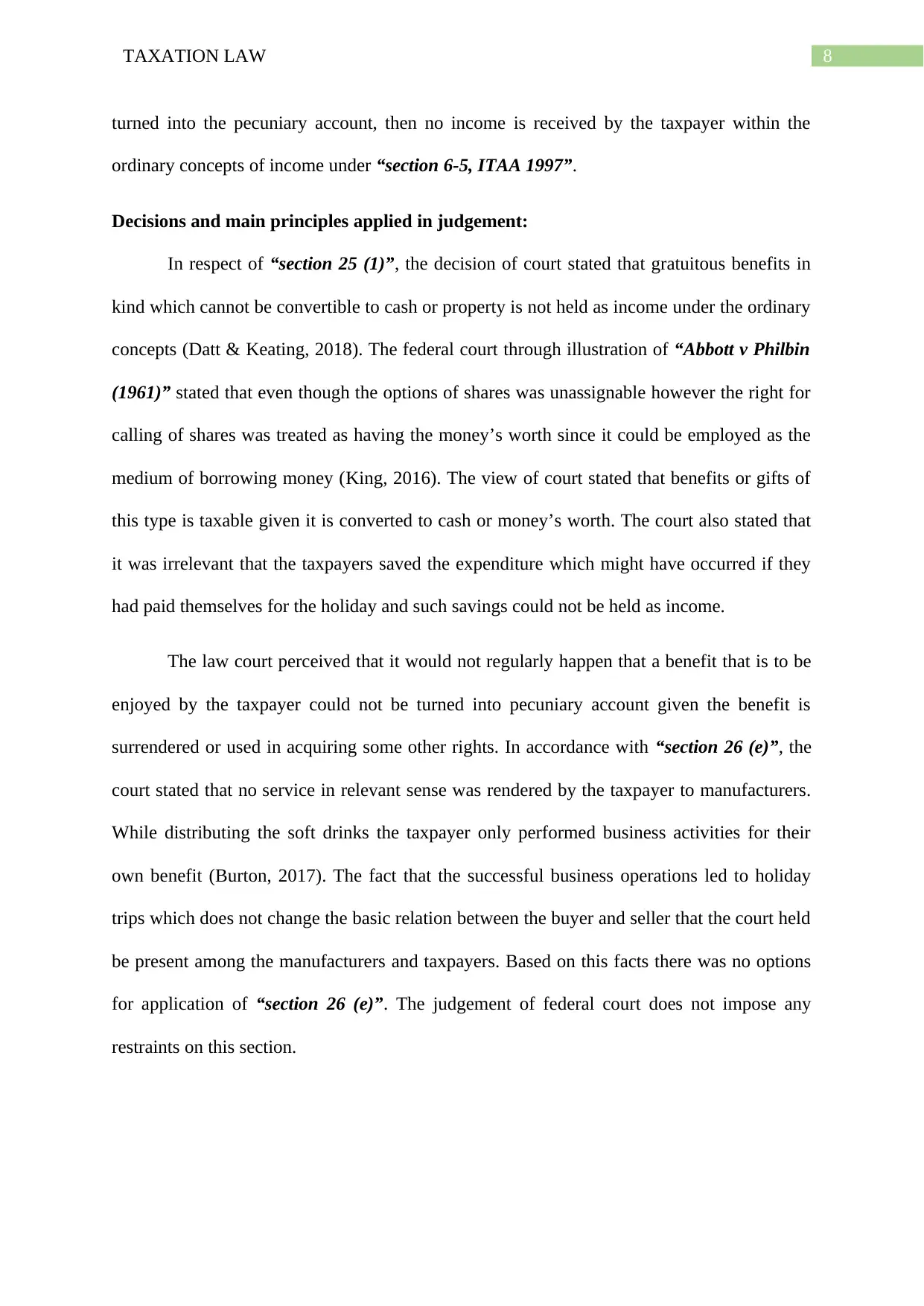
8TAXATION LAW
turned into the pecuniary account, then no income is received by the taxpayer within the
ordinary concepts of income under “section 6-5, ITAA 1997”.
Decisions and main principles applied in judgement:
In respect of “section 25 (1)”, the decision of court stated that gratuitous benefits in
kind which cannot be convertible to cash or property is not held as income under the ordinary
concepts (Datt & Keating, 2018). The federal court through illustration of “Abbott v Philbin
(1961)” stated that even though the options of shares was unassignable however the right for
calling of shares was treated as having the money’s worth since it could be employed as the
medium of borrowing money (King, 2016). The view of court stated that benefits or gifts of
this type is taxable given it is converted to cash or money’s worth. The court also stated that
it was irrelevant that the taxpayers saved the expenditure which might have occurred if they
had paid themselves for the holiday and such savings could not be held as income.
The law court perceived that it would not regularly happen that a benefit that is to be
enjoyed by the taxpayer could not be turned into pecuniary account given the benefit is
surrendered or used in acquiring some other rights. In accordance with “section 26 (e)”, the
court stated that no service in relevant sense was rendered by the taxpayer to manufacturers.
While distributing the soft drinks the taxpayer only performed business activities for their
own benefit (Burton, 2017). The fact that the successful business operations led to holiday
trips which does not change the basic relation between the buyer and seller that the court held
be present among the manufacturers and taxpayers. Based on this facts there was no options
for application of “section 26 (e)”. The judgement of federal court does not impose any
restraints on this section.
turned into the pecuniary account, then no income is received by the taxpayer within the
ordinary concepts of income under “section 6-5, ITAA 1997”.
Decisions and main principles applied in judgement:
In respect of “section 25 (1)”, the decision of court stated that gratuitous benefits in
kind which cannot be convertible to cash or property is not held as income under the ordinary
concepts (Datt & Keating, 2018). The federal court through illustration of “Abbott v Philbin
(1961)” stated that even though the options of shares was unassignable however the right for
calling of shares was treated as having the money’s worth since it could be employed as the
medium of borrowing money (King, 2016). The view of court stated that benefits or gifts of
this type is taxable given it is converted to cash or money’s worth. The court also stated that
it was irrelevant that the taxpayers saved the expenditure which might have occurred if they
had paid themselves for the holiday and such savings could not be held as income.
The law court perceived that it would not regularly happen that a benefit that is to be
enjoyed by the taxpayer could not be turned into pecuniary account given the benefit is
surrendered or used in acquiring some other rights. In accordance with “section 26 (e)”, the
court stated that no service in relevant sense was rendered by the taxpayer to manufacturers.
While distributing the soft drinks the taxpayer only performed business activities for their
own benefit (Burton, 2017). The fact that the successful business operations led to holiday
trips which does not change the basic relation between the buyer and seller that the court held
be present among the manufacturers and taxpayers. Based on this facts there was no options
for application of “section 26 (e)”. The judgement of federal court does not impose any
restraints on this section.
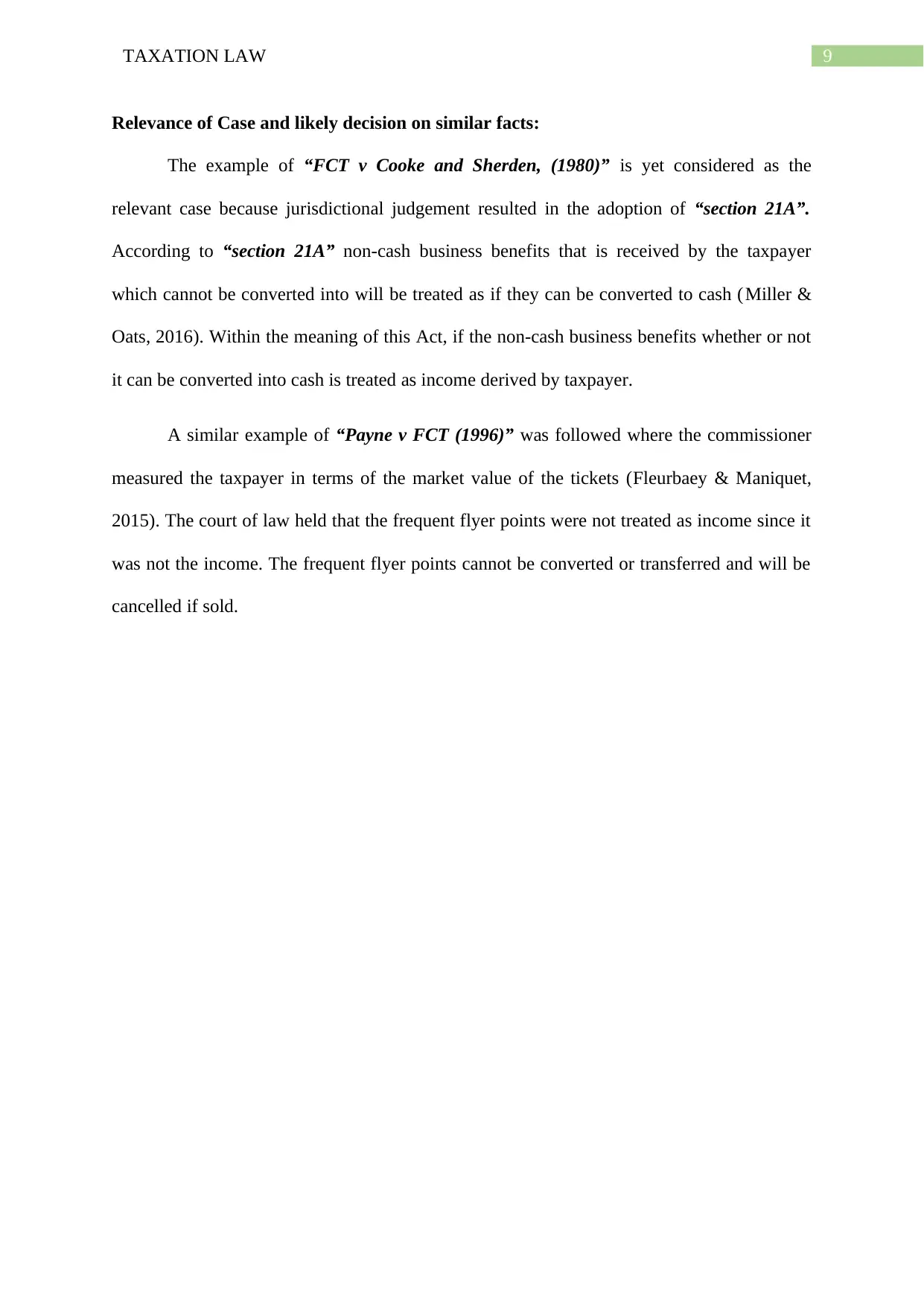
9TAXATION LAW
Relevance of Case and likely decision on similar facts:
The example of “FCT v Cooke and Sherden, (1980)” is yet considered as the
relevant case because jurisdictional judgement resulted in the adoption of “section 21A”.
According to “section 21A” non-cash business benefits that is received by the taxpayer
which cannot be converted into will be treated as if they can be converted to cash (Miller &
Oats, 2016). Within the meaning of this Act, if the non-cash business benefits whether or not
it can be converted into cash is treated as income derived by taxpayer.
A similar example of “Payne v FCT (1996)” was followed where the commissioner
measured the taxpayer in terms of the market value of the tickets (Fleurbaey & Maniquet,
2015). The court of law held that the frequent flyer points were not treated as income since it
was not the income. The frequent flyer points cannot be converted or transferred and will be
cancelled if sold.
Relevance of Case and likely decision on similar facts:
The example of “FCT v Cooke and Sherden, (1980)” is yet considered as the
relevant case because jurisdictional judgement resulted in the adoption of “section 21A”.
According to “section 21A” non-cash business benefits that is received by the taxpayer
which cannot be converted into will be treated as if they can be converted to cash (Miller &
Oats, 2016). Within the meaning of this Act, if the non-cash business benefits whether or not
it can be converted into cash is treated as income derived by taxpayer.
A similar example of “Payne v FCT (1996)” was followed where the commissioner
measured the taxpayer in terms of the market value of the tickets (Fleurbaey & Maniquet,
2015). The court of law held that the frequent flyer points were not treated as income since it
was not the income. The frequent flyer points cannot be converted or transferred and will be
cancelled if sold.
Secure Best Marks with AI Grader
Need help grading? Try our AI Grader for instant feedback on your assignments.
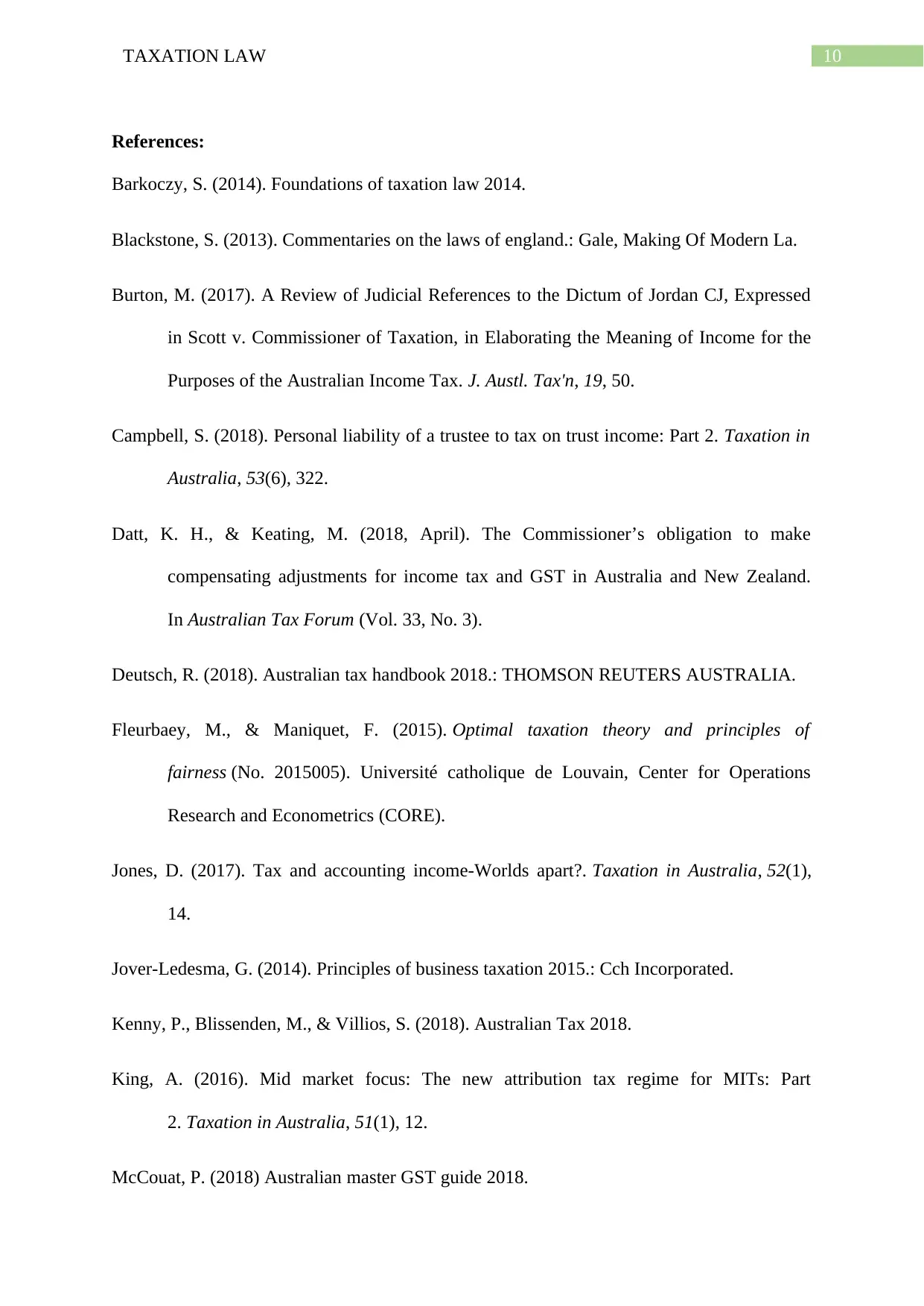
10TAXATION LAW
References:
Barkoczy, S. (2014). Foundations of taxation law 2014.
Blackstone, S. (2013). Commentaries on the laws of england.: Gale, Making Of Modern La.
Burton, M. (2017). A Review of Judicial References to the Dictum of Jordan CJ, Expressed
in Scott v. Commissioner of Taxation, in Elaborating the Meaning of Income for the
Purposes of the Australian Income Tax. J. Austl. Tax'n, 19, 50.
Campbell, S. (2018). Personal liability of a trustee to tax on trust income: Part 2. Taxation in
Australia, 53(6), 322.
Datt, K. H., & Keating, M. (2018, April). The Commissioner’s obligation to make
compensating adjustments for income tax and GST in Australia and New Zealand.
In Australian Tax Forum (Vol. 33, No. 3).
Deutsch, R. (2018). Australian tax handbook 2018.: THOMSON REUTERS AUSTRALIA.
Fleurbaey, M., & Maniquet, F. (2015). Optimal taxation theory and principles of
fairness (No. 2015005). Université catholique de Louvain, Center for Operations
Research and Econometrics (CORE).
Jones, D. (2017). Tax and accounting income-Worlds apart?. Taxation in Australia, 52(1),
14.
Jover-Ledesma, G. (2014). Principles of business taxation 2015.: Cch Incorporated.
Kenny, P., Blissenden, M., & Villios, S. (2018). Australian Tax 2018.
King, A. (2016). Mid market focus: The new attribution tax regime for MITs: Part
2. Taxation in Australia, 51(1), 12.
McCouat, P. (2018) Australian master GST guide 2018.
References:
Barkoczy, S. (2014). Foundations of taxation law 2014.
Blackstone, S. (2013). Commentaries on the laws of england.: Gale, Making Of Modern La.
Burton, M. (2017). A Review of Judicial References to the Dictum of Jordan CJ, Expressed
in Scott v. Commissioner of Taxation, in Elaborating the Meaning of Income for the
Purposes of the Australian Income Tax. J. Austl. Tax'n, 19, 50.
Campbell, S. (2018). Personal liability of a trustee to tax on trust income: Part 2. Taxation in
Australia, 53(6), 322.
Datt, K. H., & Keating, M. (2018, April). The Commissioner’s obligation to make
compensating adjustments for income tax and GST in Australia and New Zealand.
In Australian Tax Forum (Vol. 33, No. 3).
Deutsch, R. (2018). Australian tax handbook 2018.: THOMSON REUTERS AUSTRALIA.
Fleurbaey, M., & Maniquet, F. (2015). Optimal taxation theory and principles of
fairness (No. 2015005). Université catholique de Louvain, Center for Operations
Research and Econometrics (CORE).
Jones, D. (2017). Tax and accounting income-Worlds apart?. Taxation in Australia, 52(1),
14.
Jover-Ledesma, G. (2014). Principles of business taxation 2015.: Cch Incorporated.
Kenny, P., Blissenden, M., & Villios, S. (2018). Australian Tax 2018.
King, A. (2016). Mid market focus: The new attribution tax regime for MITs: Part
2. Taxation in Australia, 51(1), 12.
McCouat, P. (2018) Australian master GST guide 2018.
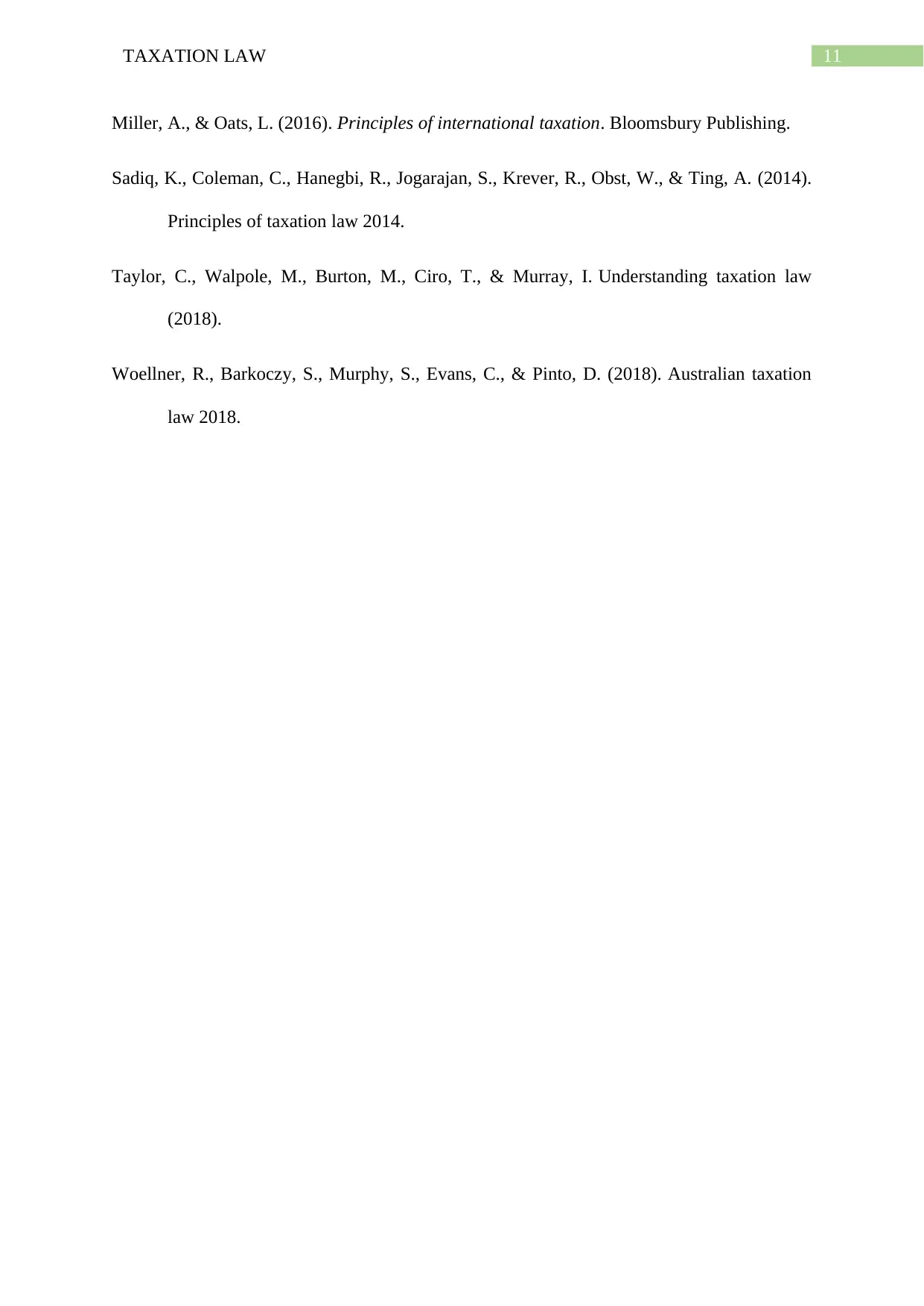
11TAXATION LAW
Miller, A., & Oats, L. (2016). Principles of international taxation. Bloomsbury Publishing.
Sadiq, K., Coleman, C., Hanegbi, R., Jogarajan, S., Krever, R., Obst, W., & Ting, A. (2014).
Principles of taxation law 2014.
Taylor, C., Walpole, M., Burton, M., Ciro, T., & Murray, I. Understanding taxation law
(2018).
Woellner, R., Barkoczy, S., Murphy, S., Evans, C., & Pinto, D. (2018). Australian taxation
law 2018.
Miller, A., & Oats, L. (2016). Principles of international taxation. Bloomsbury Publishing.
Sadiq, K., Coleman, C., Hanegbi, R., Jogarajan, S., Krever, R., Obst, W., & Ting, A. (2014).
Principles of taxation law 2014.
Taylor, C., Walpole, M., Burton, M., Ciro, T., & Murray, I. Understanding taxation law
(2018).
Woellner, R., Barkoczy, S., Murphy, S., Evans, C., & Pinto, D. (2018). Australian taxation
law 2018.
1 out of 12
Related Documents
Your All-in-One AI-Powered Toolkit for Academic Success.
+13062052269
info@desklib.com
Available 24*7 on WhatsApp / Email
![[object Object]](/_next/static/media/star-bottom.7253800d.svg)
Unlock your academic potential
© 2024 | Zucol Services PVT LTD | All rights reserved.





